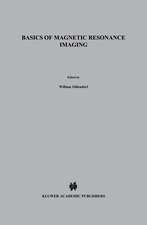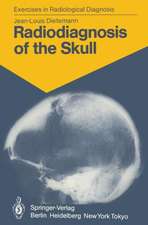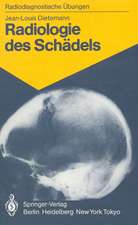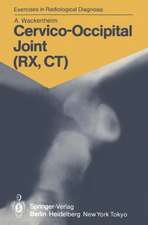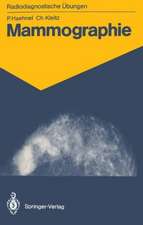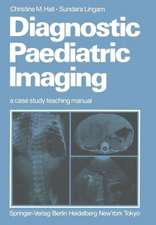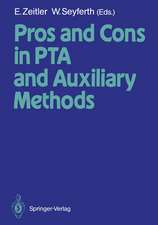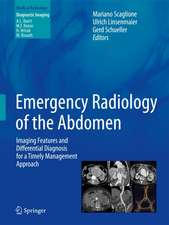MRI of the Lung: Medical Radiology
Editat de Hans-Ulrich Kauczor, Mark Oliver Wielpützen Limba Engleză Paperback – 10 dec 2019
During the past two decades, significant advances in the technology have enabled MRI to enter and mature in the clinical arena of chest imaging. Standard protocols are now readily available on MR scanners, and MRI is recommended as the first- or second-line imaging modality for a variety of lung diseases, not limited to cystic fibrosis, pulmonary hypertension, and lung cancer. The benefits and added value of MRI originate from its ability to both visualize lung structure and provide information on different aspects of lung function, such as perfusion, respiratory motion, ventilation, and gas exchange. On this basis, novel quantitative surrogates for lung function and therapy control (imaging biomarkers) are generated.
The second edition of MRI of the Lung has been fully updated to take account of recent advances. It is written by an internationally balanced team of renowned authors representing all major groups in the field.
| Toate formatele și edițiile | Preț | Express |
|---|---|---|
| Paperback (1) | 861.84 lei 6-8 săpt. | |
| Springer International Publishing – 10 dec 2019 | 861.84 lei 6-8 săpt. | |
| Hardback (1) | 1312.22 lei 6-8 săpt. | |
| Springer International Publishing – 10 oct 2018 | 1312.22 lei 6-8 săpt. |
Din seria Medical Radiology
- 5%
 Preț: 1626.03 lei
Preț: 1626.03 lei - 5%
 Preț: 349.23 lei
Preț: 349.23 lei - 5%
 Preț: 1317.17 lei
Preț: 1317.17 lei - 5%
 Preț: 1450.84 lei
Preț: 1450.84 lei - 5%
 Preț: 720.68 lei
Preț: 720.68 lei - 5%
 Preț: 743.16 lei
Preț: 743.16 lei - 5%
 Preț: 1605.08 lei
Preț: 1605.08 lei - 5%
 Preț: 663.23 lei
Preț: 663.23 lei - 5%
 Preț: 1130.07 lei
Preț: 1130.07 lei - 5%
 Preț: 475.00 lei
Preț: 475.00 lei - 5%
 Preț: 1986.27 lei
Preț: 1986.27 lei - 5%
 Preț: 1953.34 lei
Preț: 1953.34 lei - 5%
 Preț: 1308.74 lei
Preț: 1308.74 lei - 5%
 Preț: 1105.61 lei
Preț: 1105.61 lei - 5%
 Preț: 718.46 lei
Preț: 718.46 lei - 5%
 Preț: 1435.85 lei
Preț: 1435.85 lei - 5%
 Preț: 731.07 lei
Preț: 731.07 lei - 5%
 Preț: 1113.99 lei
Preț: 1113.99 lei - 5%
 Preț: 802.21 lei
Preț: 802.21 lei - 5%
 Preț: 216.32 lei
Preț: 216.32 lei - 5%
 Preț: 1858.27 lei
Preț: 1858.27 lei - 5%
 Preț: 383.93 lei
Preț: 383.93 lei - 5%
 Preț: 1113.11 lei
Preț: 1113.11 lei - 5%
 Preț: 1462.37 lei
Preț: 1462.37 lei - 5%
 Preț: 783.04 lei
Preț: 783.04 lei - 5%
 Preț: 975.17 lei
Preț: 975.17 lei - 5%
 Preț: 1116.00 lei
Preț: 1116.00 lei - 5%
 Preț: 794.00 lei
Preț: 794.00 lei - 5%
 Preț: 1301.44 lei
Preț: 1301.44 lei - 5%
 Preț: 1108.87 lei
Preț: 1108.87 lei - 5%
 Preț: 717.20 lei
Preț: 717.20 lei - 5%
 Preț: 1298.14 lei
Preț: 1298.14 lei - 5%
 Preț: 1122.58 lei
Preț: 1122.58 lei - 5%
 Preț: 821.18 lei
Preț: 821.18 lei - 5%
 Preț: 1101.21 lei
Preț: 1101.21 lei - 5%
 Preț: 1618.70 lei
Preț: 1618.70 lei - 5%
 Preț: 1184.42 lei
Preț: 1184.42 lei - 5%
 Preț: 1308.02 lei
Preț: 1308.02 lei - 5%
 Preț: 1420.29 lei
Preț: 1420.29 lei - 5%
 Preț: 1306.73 lei
Preț: 1306.73 lei - 5%
 Preț: 1126.82 lei
Preț: 1126.82 lei - 5%
 Preț: 1124.07 lei
Preț: 1124.07 lei - 5%
 Preț: 906.63 lei
Preț: 906.63 lei - 5%
 Preț: 733.09 lei
Preț: 733.09 lei - 5%
 Preț: 1110.32 lei
Preț: 1110.32 lei - 5%
 Preț: 1313.72 lei
Preț: 1313.72 lei - 5%
 Preț: 1437.67 lei
Preț: 1437.67 lei - 5%
 Preț: 1307.85 lei
Preț: 1307.85 lei - 5%
 Preț: 1950.60 lei
Preț: 1950.60 lei
Preț: 861.84 lei
Preț vechi: 907.20 lei
-5% Nou
Puncte Express: 1293
Preț estimativ în valută:
164.93€ • 172.40$ • 139.37£
164.93€ • 172.40$ • 139.37£
Carte tipărită la comandă
Livrare economică 07-21 martie
Preluare comenzi: 021 569.72.76
Specificații
ISBN-13: 9783030132552
ISBN-10: 3030132552
Pagini: 518
Ilustrații: XII, 518 p. 92 illus., 89 illus. in color.
Dimensiuni: 178 x 254 mm
Greutate: 0.91 kg
Ediția:Softcover reprint of the original 2nd ed. 2018
Editura: Springer International Publishing
Colecția Springer
Seriile Medical Radiology, Diagnostic Imaging
Locul publicării:Cham, Switzerland
ISBN-10: 3030132552
Pagini: 518
Ilustrații: XII, 518 p. 92 illus., 89 illus. in color.
Dimensiuni: 178 x 254 mm
Greutate: 0.91 kg
Ediția:Softcover reprint of the original 2nd ed. 2018
Editura: Springer International Publishing
Colecția Springer
Seriile Medical Radiology, Diagnostic Imaging
Locul publicării:Cham, Switzerland
Cuprins
General Requirements of MRI of the Lung and Suggested Standard Protocol.- Noncontrast and Contrast-Enhanced Pulmonary Magnetic Resonance Angiography.- MR Perfusion in the Lung.- Hyperpolarised Helium-3 (3He) MRI: Physical Methods for Imaging Human Lung Function.- Hyperpolarized 129Xenon MRI of the Lung.- Fluorinated-Gas MRI.- Proton MRI Based Ventilation Imaging: Oxygen-Enhanced Lung MRI and Alternative Approaches.- Dynamic MRI of Respiratory Mechanics and Pulmonary Motion.-Pulmonary Hypertension and Thromboembolic Disease.-Vascular Anomalies and Diseases.- Asthma.- MRI of Chronic Obstructive Pulmonary Disease.- Magnetic Resonance Imaging of the Lung: Cystic Fibrosis.- Lung Cancer.- Mediastinal Disease.- Pulmonary Infections: Pneumonia.- Interstitial Lung Disease.- Diseases of the Pleura and the Chest Wall.- Magnetic Resonance Imaging in Animal Models of Respiratory Diseases.- Pulmonary MRI in Clinical Trials.- Challenges of Using 3 T MR Systems and Whole-Body MRI for Lung Imaging.
Recenzii
“This is a very well written book and benefits from colour figures embedded throughout the text. … the growth of thoracic applications of MRI and the exciting opportunities both in research and clinical practice make this a perfect starting point for anyone planning a lung MRI based project (it would be invaluable as a starting point for a thesis introduction) or considering setting up a clinical lung MRI service.” (Thomas Semple, RAD Magazine, December, 2019)
Notă biografică
Hans-Ulrich Kauczor is Full Professor and Chairman of Radiology at the University of Heidelberg as well as the Medical Director of the Department of Diagnostic and Interventional Radiology.
He studied Medicine at the Universities of Bonn, Heidelberg and Cologne. He started his Radiology Residency in 1989 at the University Hospital Mainz and received his Habilitation degree as University Lecturer in 1998. From 1996 until 2002 he acted as Assistant Professor for chest radiology at the University Hospital Mainz. In 2003 he became Full Professor for Radiology and lead the Department of Radiology at the German Cancer Research Center (DKFZ) in Heidelberg before taking the Chairmanship of Radiology at the University of Heidelberg in 2008.
He was among the first to implement 3Helium MRI in clinical trials. Since then, his group has focused on standard protocols for routine comprehensive proton MRI of lung disease. He has been President of the European Society of Thoracic Imaging in 2011 and the Fleischner Society in 2015.
Mark Oliver Wielpütz is a Senior Radiologist at the University Hospital of Heidelberg. He studied Medicine at the Universities of Erlangen-Nuremberg and Sydney from 2002 to 2008. Thereafter he took his Residency in the Department of Diagnostic and Interventional Radiology at the University Hospital of Heidelberg. He received his Board Certification in 2014 and the European Diploma in Radiology in 2015. His main research interest is in functional imaging in chronic obstructive pulmonary diseases and cystic fibrosis, and his work helped to introduce lung MRI into routine clinical practice. He received his Habilitation degree as University Lecturer in 2016.
He studied Medicine at the Universities of Bonn, Heidelberg and Cologne. He started his Radiology Residency in 1989 at the University Hospital Mainz and received his Habilitation degree as University Lecturer in 1998. From 1996 until 2002 he acted as Assistant Professor for chest radiology at the University Hospital Mainz. In 2003 he became Full Professor for Radiology and lead the Department of Radiology at the German Cancer Research Center (DKFZ) in Heidelberg before taking the Chairmanship of Radiology at the University of Heidelberg in 2008.
He was among the first to implement 3Helium MRI in clinical trials. Since then, his group has focused on standard protocols for routine comprehensive proton MRI of lung disease. He has been President of the European Society of Thoracic Imaging in 2011 and the Fleischner Society in 2015.
Mark Oliver Wielpütz is a Senior Radiologist at the University Hospital of Heidelberg. He studied Medicine at the Universities of Erlangen-Nuremberg and Sydney from 2002 to 2008. Thereafter he took his Residency in the Department of Diagnostic and Interventional Radiology at the University Hospital of Heidelberg. He received his Board Certification in 2014 and the European Diploma in Radiology in 2015. His main research interest is in functional imaging in chronic obstructive pulmonary diseases and cystic fibrosis, and his work helped to introduce lung MRI into routine clinical practice. He received his Habilitation degree as University Lecturer in 2016.
Textul de pe ultima copertă
This book provides a comprehensive overview of how to use MRI for the imaging of lung disease. Special emphasis is placed on routine applications and the clinical impact of MRI in each setting. In addition, current technological developments are reviewed and information presented on dedicated applications of MRI in preclinical and translational research, clinical trials, and specialized institutions.
During the past two decades, significant advances in the technology have enabled MRI to enter and mature in the clinical arena of chest imaging. Standard protocols are now readily available on MR scanners, and MRI is recommended as the first- or second-line imaging modality for a variety of lung diseases, not limited to cystic fibrosis, pulmonary hypertension, and lung cancer. The benefits and added value of MRI originate from its ability to both visualize lung structure and provide information on different aspects of lung function, such as perfusion, respiratory motion, ventilation, and gas exchange. On this basis, novel quantitative surrogates for lung function and therapy control (imaging biomarkers) are generated.
The second edition of MRI of the Lung has been fully updated to take account of recent advances. It is written by an internationally balanced team of renowned authors representing all major groups in the field.
During the past two decades, significant advances in the technology have enabled MRI to enter and mature in the clinical arena of chest imaging. Standard protocols are now readily available on MR scanners, and MRI is recommended as the first- or second-line imaging modality for a variety of lung diseases, not limited to cystic fibrosis, pulmonary hypertension, and lung cancer. The benefits and added value of MRI originate from its ability to both visualize lung structure and provide information on different aspects of lung function, such as perfusion, respiratory motion, ventilation, and gas exchange. On this basis, novel quantitative surrogates for lung function and therapy control (imaging biomarkers) are generated.
The second edition of MRI of the Lung has been fully updated to take account of recent advances. It is written by an internationally balanced team of renowned authors representing all major groups in the field.
Caracteristici
Provides a general and comprehensive overview of the use of MRI for imaging of lung disease Places special emphasis on routine applications and the clinical impact of MRI Reviews the latest technological developments Written by an internationally balanced team of renowned authors representing all major groups in the field


